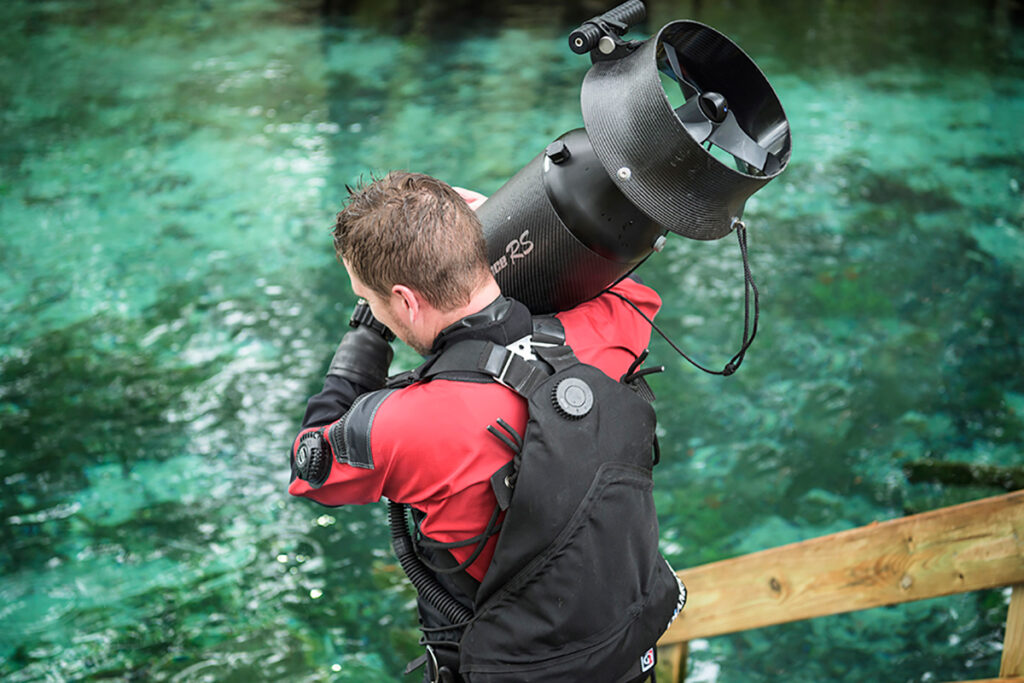Cave DPV
This course is designed to teach trained cave divers how to utilize Diver Propulsion Vehicles (DPVs) in the cave environment. Divers will learn about safe DPV use, DPV components, and care and maintenance. Students will learn to plan dives that may incorporate extended penetration, longer bottom times, complex dive planning, and proper methods of gas management.

What you can expect to learn
- Motivations for DPV cave diving
- Advantages of DPV use
- Equipment considerations
- DPV options
- DPV components
- Rated burn time
- Care and Maintenance
- DPV rigging
- Helmets
- Problem solving procedures
- DPV malfunction or failure
- Towing
- Gas sharing with DPVs
- Light failure
- Entanglement
- Collision avoidance
- Team separation
- Environmental considerations
- Appropriate vs. inappropriate passages
- Suitable cave conditions
- Low impact DPV use
- DPV diving techniques
- Buoyancy and trim with DPV
- Dropping, securing, and retrieving a DPV
- Installing guidelines with a DPV
- Instigating directional and depth changes
- DPV courtesy and etiquette
- Dive planning and gas management
- Turn time, turn distance, and turn pressure
- Gas mix(es) and NDLs or decompression obligations
Some of the required skills you will have to demonstrate include:
- Demonstrate adequate pre-dive planning
- Equipment check and equipment matching
- Bubble check
- Demonstrate specialized propulsion techniques in varying types of flow
- Demonstrate proper buoyancy control
- Demonstrate proper body posture
- Demonstrate proper stress analysis (detection and management)
- Share gas with DPVs while maintaining visual contact with the guideline.
- Simulate primary light failure and exit utilizing the DPV and the smallest backup light
- Simulate exiting the cave with disabled DPV
- Exit while towing a team member and his disabled DPV
Course Equipment Requirements
- Dual cylinders, volume appropriate for planned dive, student gas consumption
- Two independent first and second stage regulators; one regulator equipped with a long hose at a recommended minimum length; 2 metres / 7 feet
- Submersible pressure gauge
- Buoyancy compensator device (BCD) with power inflator
- Exposure suit adequate for diving environment
- Mask and fins, NO snorkel
- Two line cutting devices
- Three battery powered lights; 1 primary and 2 back-ups, each with a with burn time suitable for the planned dive time
- One primary cave-diving reel with length appropriate for intended dive
- Safety reel with a minimum of 37 metres / 125 feet of guideline
- Appropriate number of gap and jump reels with 15 metres / 50 feet of guideline
- Computer, watch or bottom timer and depth gauge
- Slate or wet notes with a pencil
- Submersible dive tables or back up dive computer
- Three directional line arrows
- One non-directional line marker
- DPV adequately configured for the cave environment Instructor must use full cave diving equipment during all water exercises
Course Prerequisites
- Minimum age 18
- Certified as a TDI Full Cave Diver or equivalent
- Provide proof of at least 25 non-training full cave dives
Want to know more?
Ask more questions or schedule any of these courses Email Us.
